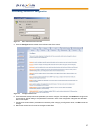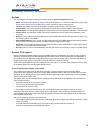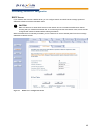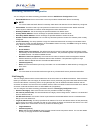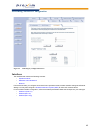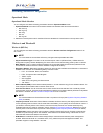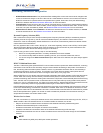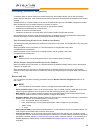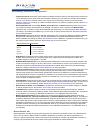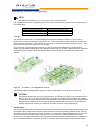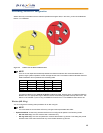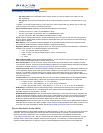
44
Performing Advanced Configuration
• RTS/CTS Medium Reservation: This parameter affects message flow control and should not be changed under
normal circumstances. Range is 0 to 2347. When set to a value between 0 and 2347, the Access Point uses the
RTS/CTS mechanism for packets that are the specified size or greater. When set to 2347 (the default setting),
RTS/CTS is disabled. See RTS/CTS Medium Reservation for more information.
• Closed System: Check this box to allow only clients configured with the Access Point’s specific Network Name to
associate with the Access Point. When enabled, a client configured with the Network Name “ANY” cannot connect
to the AP. This option is disabled by default. See Broadcast SSID and Closed System for more information.
• Wireless Service Status: Select shutdown to shutdown the wireless service on a wireless interface, or resume
to resume wireless service. See Wireless Service Status for more information.
Dynamic Frequency Selection (DFS)
802.11a APs sold in Europe use a technique called Dynamic Frequency Selection (DFS) to automatically select an
operating channel. During boot-up, the AP scans the available frequency and selects a channel that is free of
interference. If the AP subsequently detects interference on its channel, it automatically reboots and selects another
channel that is free of interference.
DFS only applies to 802.11a APs used in Europe (i.e., units whose regulatory domain is set to ETSI). The European
Telecommunications Standard Institute (ETSI) requires that 802.11a devices use DFS to prevent interference with
radar systems and other devices that already occupy the 5 GHz band.
If you are using an 802.11a AP in Europe, keep in mind the following:
• DFS is not a configurable parameter. It is always enabled and cannot be disabled.
• You cannot manually select the device’s operating channel; you must let DFS select the channel.
• You cannot configure the Auto Channel Select option. Within the HTTP interface, this option always appears
enabled.
RTS/CTS Medium Reservation
The 802.11 standard supports optional RTS/CTS communication based on packet size. Without RTS/CTS, a sending
radio listens to see if another radio is already using the medium before transmitting a data packet. If the medium is
free, the sending radio transmits its packet. However, there is no guarantee that another radio is not transmitting a
packet at the same time, causing a collision. This typically occurs when there are hidden nodes (clients that can
communicate with the Access Point but are out of range of each other) in very large cells.
When RTS/CTS occurs, the sending radio first transmits a Request to Send (RTS) packet to confirm that the medium
is clear. When the receiving radio successfully receives the RTS packet, it transmits back a Clear to Send (CTS)
packet to the sending radio. When the sending radio receives the CTS packet, it sends the data packet to the receiving
radio. The RTS and CTS packets contain a reservation time to notify other radios (including hidden nodes) that the
medium is in use for a specified period. This helps to minimize collisions. While RTS/CTS adds overhead to the radio
network, it is particularly useful for large packets that take longer to resend after a collision occurs.
RTS/CTS Medium Reservation is an advanced parameter and supports a range between 0 and 2347 bytes. When set
to 2347 (the default setting), the RTS/CTS mechanism is disabled. When set to 0, the RTS/CTS mechanism is used
for all packets. When set to a value between 0 and 2347, the Access Point uses the RTS/CTS mechanism for packets
that are the specified size or greater. You should not need to enable this parameter for most networks unless you
suspect that the wireless cell contains hidden nodes.
Wireless Service Status
The user can shutdown (or resume) the wireless service on the wireless interface of the AP through the CLI, HTTP, or
SNMP interface. When the wireless service on a wireless interface is shutdown, the AP will:
• Stop the AP services to wireless clients connected on that wireless interface by disassociating them
• Disable the associated BSS ports on that interface
• Disable the transmission and reception of frames on that interface
• Indicate the wireless service shutdown status of the wireless interface through LED and traps
• Enable Ethernet interface so that it can receive a wireless service resume command through CLI/HTTP/SNMP
interface
NOTE
WSS disables only BSS ports; WDS ports are still operational.




